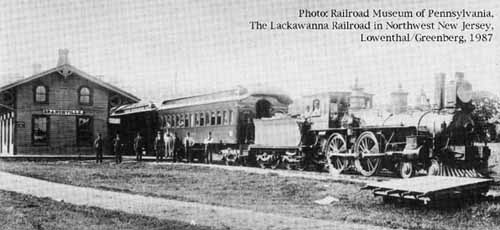| Main Index |
| History Index |
| Modeling Index |
| 1840's |
| 1850's |
| 1860's |
| 1870's |
| 1880's |
| 1890's |
| 1900's |
| 1910's |
| 1920's |
| 1930's |
| 1940's |
| 1950's |
| 1960's |
| 1970's |
| 1980's |
| 1990's |
| 2000's |
Archives>Article
New Jersey Herald - December 22, 1955 issue
'Out of the Past' This photograph is from the collection of Harold N. Coriell of Newton and depicts that famous locomotive, the "John I. Blair," at the head of a passenger train ready to pull out of the Branchville depot back in the {eighteen} Eighties. It is believed the engineer was Elmer Decker, of Newton, a noted oldtime railroader on the Sussex Railroad, and father of Mrs. J. Russell Roof, who is living today on Elm Street in Newton. The old Sussex Railroad that really opened up Newton to the outside world, was built from Waterloo to Newton in 1854, and extended on to Branchville and Franklin around 1870. {1869 actually} It was an independent pike, built by Cooper & Hewitt, the famous ironmasters who owned and operated the rich iron mines at Andover and who constructed the railroad originally to haul iron ore from the Andover mines to the Morris Canal at Waterloo. In those days the automobile was undreamed of and travelers either had to get to their destination about the county on foot or by horse and wagon, so when the Sussex Railroad came into Newton in November, 1854, {December 11} the town went crazy with enthusiasm.
Newton became the shipping point for the whole county, surpassing the honors formerly held by Waterloo in the old Morris Canal Days. Farmers brought wagon loads of hogs, butter and farm produce into Newton from many miles around and often there would be a line of wagons waiting to unload, all the way from the depot up spring street to the Court House. The head offices of the Sussex Railroad were in the Newton depot, which is still standing and in service, and the second floor was used by the superintendent and his assistants.
The original locomotives were Woodburners, as is shown in this photograph, and the company had a big wood yard, sawmill and blacksmith shop at Branchville Junction. The passenger coaches of those days were equipped with pot-bellied stoves, one in each end of the car, and in the long and snowy winters of those turbulent years, these stoves would glisten cherry-red and be surrounded by travelers soaking in the general warmth as they rode on business or pleasure between Waterloo and Newton, Lafayette, Branchville or Franklin.
[There is a little more in reference to this article here.]
